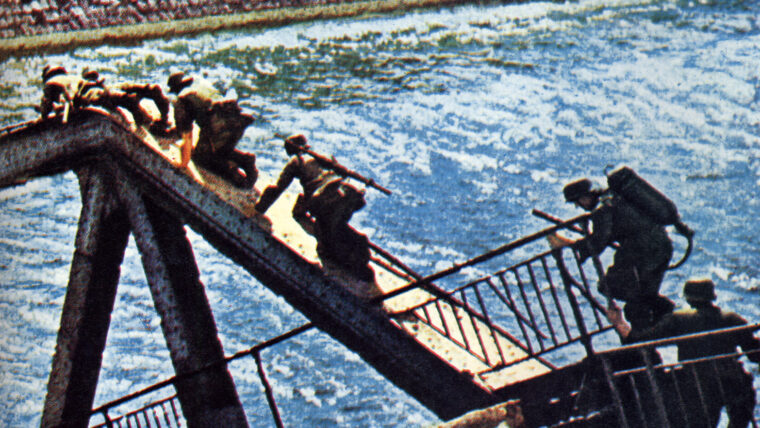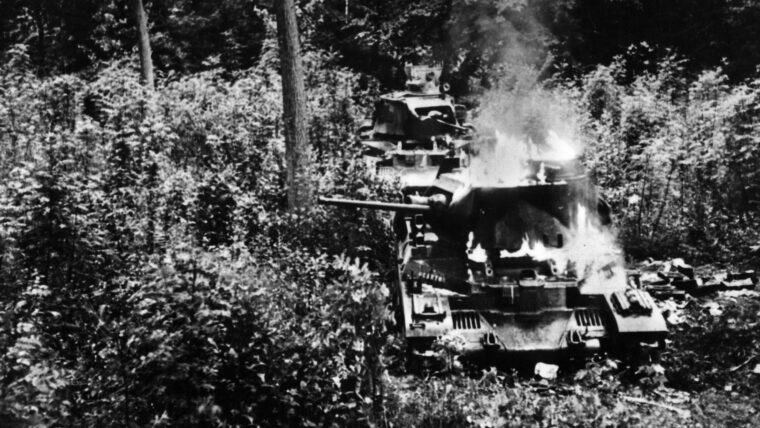
WWII
Omaha Beach H-Hour D-Day June 6, 1944
By Joseph BalkoskiEditor’s Note: The following is excerpted from Omaha Beach: D-Day June 6, 1944 by Joseph Balkoski (Stackpole Books, 2004; www.stackpolebooks.com). Read more


WWII
Editor’s Note: The following is excerpted from Omaha Beach: D-Day June 6, 1944 by Joseph Balkoski (Stackpole Books, 2004; www.stackpolebooks.com). Read more

WWII
In the early 1970s, a former British Royal Air Force policeman–turned-hairdresser, Ken Small, visited South Devon on England’s Channel coast. Read more

WWII
When World War II began in September 1939, just nine months before the Siege of Malta, its three small islands in the central Mediterranean were still considered part of the British Commonwealth. Read more

WWII
I was always fascinated by the mastery of water,” Sir Donald Coleman Bailey reflected, long after the end of World War II. Read more

WWII
As he watched the preliminary bombardment from the railing of his ship, Colonel Lewis B. “Chesty” Puller had deep reservations. Read more

WWII
Freighter Ehrenfels’ siren shrieked through the muggy night across the harbor. As the captain pulled down hard on the alarm cord, the alarm howled out over the steaming darkness, screaming that British raiders were in the harbor, alerting Ehrenfels’ crew and calling for help from ashore. Read more

WWII
On the vast Eastern Front, the Demyansk salient represented little more than a smudge on the battle map. Read more

WWII
In some historical circles, a mistaken impression has developed that the U.S. Navy’s Task Force 38 launched the aerial offensive on the Japanese stronghold at Rabaul, New Britain, that ultimately rendered the base useless. Read more

WWII
General George S. Patton, Jr., once said, “An army is like a piece of cooked spaghetti. You can’t push it, you have to pull it after you.” Read more

WWII
Stripped of the regalia and high position of Reich Marshal in the Nazi regime and tried as a war criminal, the former Luftwaffe chief was by far the most colorful and outspoken defendant during the postwar proceedings. Read more

WWII
Built in the mid-1930s as one of the famed Treasury class of large U.S. Coast Guard cutters, USCGC Taney had a distinguished career spanning five decades of continuous service. Read more

WWII
Shortly after midnight on Monday, June 5, 1944, the dark skies over the coast of northern France were filled with thunder. Read more

WWII
War had been raging for 10 days, and Wehrmacht columns were pouring through Poland in a ceaseless torrent. Read more

WWII
In May 1939, Mongolian herdsmen and part-time militia cavalry crossed the Khalkhin Gol, or Halha, River near the village of Nomonhan in Manchurian-claimed territory. Read more

WWII
Near the Tomb of the Unknown Soldier and beside the grave of world heavyweight boxing champion Joe Louis in Arlington National Cemetery is the resting place of a film star who chose to be remembered first and foremost as a U.S. Read more

WWII
The second World War seems like a long time ago for most of the world, with the harsh realities of blitzkrieg warfare and the Holocaust primarily learned through books and films, possibly a museum. Read more

WWII
For nearly three years World War II in the Pacific surged, raging in a hundred places from the Coral Sea to Guam, from Guadalcanal to Tarawa, and from Wake Island to the Philippines. Read more

WWII
The bleak opening days of World War II in the Pacific found the American territory of the Philippines under attack from the Japanese. Read more

WWII
Shortly after noon on Tuesday, December 9, 1941, in the wake of the Japanese attack on Pearl Harbor, hostile warplanes were reported 200 miles off the Virginia coast and heading for New York City. Read more

WWII
The orders he received didn’t make much sense to Lord Gort, but he was going to obey them. Read more